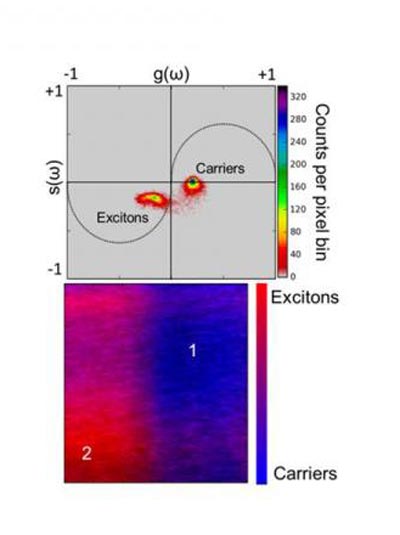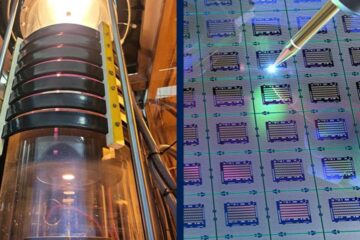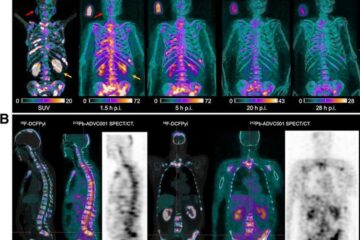New ORNL method could unleash solar power potential

(Top) A phasor plot of the transient absorption data shows the presence of free charges and excitons; a false colored image shows their contributions at different spatial positions. Credit: ORNL
While solar cells made from light-harvesting perovskite (an organic-inorganic hybrid) materials have recently eclipsed the 20 percent efficiency mark, researchers believe they could do better if they had a clearer picture of energy flow at the nanometer scale.
The ORNL discovery, described in a paper published in ACS Photonics, synchronizes microscopy, ultra-short pulses of laser light and data analytics to extract images with single-pixel precision, providing unprecedented detail.
“If we can see exactly and in real time what is happening, we can map out the electronic processes in space instead of relying on snapshots gleaned from spatial averages,” said Benjamin Doughty, one of the authors and a member of ORNL's Chemical Sciences Division.
Armed with information about what electrons are doing inside the material, researchers believe they can make improvements that lead to solar cells that are more efficient and potentially less expensive.
“With conventional approaches of studying photovoltaic materials, we are unable to accurately map out electronic processes and how electrons are getting lost,” Doughty said. “Those processes can translate into losses in efficiency.”
The experiment consists of optically pumping the thin film sample with a 50 femtosecond — or 50 millionths of a billionth of a second — laser pulse and then measuring changes in light absorption with a second laser pulse in the material. The technique, called femtosecond transient absorption microscopy, consists of a tabletop of lasers, optics and a microscope. The net result is a pixel-by-pixel map of the material being studied and information researchers can use to improve performance.
“The ability to identify what will be created after the solar cell absorbs a photon, either a pair of free charges or their bound form called an exciton, is crucial from both fundamental and applied perspectives,” said co-author Yingzhong Ma, who led the research team. “We found that both free charges and excitons are present, and the strength of our approach lies in not only identifying where they are but also determining what their relative contributions are when they are both present at a given spatial location.”
A key remaining challenge is to understand what causes the observed spatial difference, said Ma, so he and colleagues are exploring an all-optical imaging approach that would allow them to correlate electronic dynamics with underlying structural information. This approach may also help researchers map and understand perovskite degradation issues associated with moisture. Ma noted that this must be resolved before solar cells based on this class of materials can be successful.
###
Other team members were Mary Jane Simpson, the lead author and a postdoctoral research associate in the Chemical Sciences Division, and Bin Yang and Kai Xiao of ORNL's Center for Nanophase Materials Science. The paper, titled “Separation of Distinct Photoexcitation Species in Femtosecond Transient Absorption Microscopy,” is available at http://pubs.
This research was funded by DOE's Office of Science. Perovskite sample preparation was done at the Center for Nanophase Materials Sciences, a DOE Office of Science User Facility.
UT-Battelle manages ORNL for the DOE's Office of Science. The Office of Science is the single largest supporter of basic research in the physical sciences in the United States, and is working to address some of the most pressing challenges of our time. For more information, please visit http://science.
Image: https:/
Cutline: (Top) A phasor plot of the transient absorption data shows the presence of free charges and excitons; a false colored image shows their contributions at different spatial positions.
NOTE TO EDITORS: You may read other press releases from Oak Ridge National Laboratory or learn more about the lab at http://www.
Twitter — http://twitter.
RSS Feeds — http://www.
Flickr — http://www.
YouTube — http://www.
LinkedIn — http://www.
Facebook — http://www.
Media Contact
All latest news from the category: Materials Sciences
Materials management deals with the research, development, manufacturing and processing of raw and industrial materials. Key aspects here are biological and medical issues, which play an increasingly important role in this field.
innovations-report offers in-depth articles related to the development and application of materials and the structure and properties of new materials.
Newest articles

Silicon Carbide Innovation Alliance to drive industrial-scale semiconductor work
Known for its ability to withstand extreme environments and high voltages, silicon carbide (SiC) is a semiconducting material made up of silicon and carbon atoms arranged into crystals that is…

New SPECT/CT technique shows impressive biomarker identification
…offers increased access for prostate cancer patients. A novel SPECT/CT acquisition method can accurately detect radiopharmaceutical biodistribution in a convenient manner for prostate cancer patients, opening the door for more…

How 3D printers can give robots a soft touch
Soft skin coverings and touch sensors have emerged as a promising feature for robots that are both safer and more intuitive for human interaction, but they are expensive and difficult…





















